2023 TOYOTA 86 brake
[x] Cancel search: brakePage 180 of 449
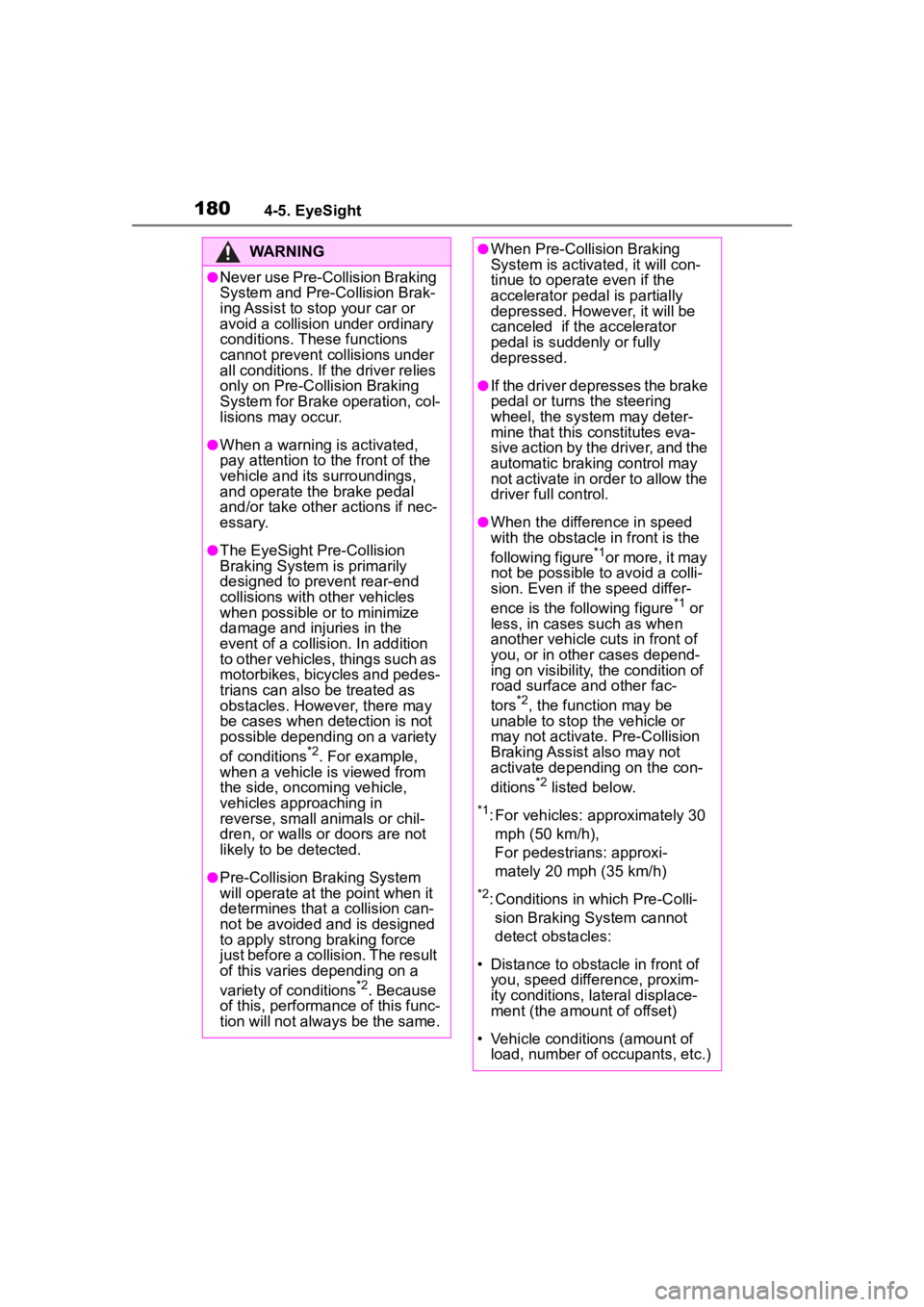
1804-5. EyeSight
WARNING
●Never use Pre-Collision Braking
System and Pre-Collision Brak-
ing Assist to stop your car or
avoid a collision under ordinary
conditions. These functions
cannot prevent collisions under
all conditions. If the driver relies
only on Pre-Collision Braking
System for Brake operation, col-
lisions may occur.
●When a warning is activated,
pay attention to the front of the
vehicle and its surroundings,
and operate the brake pedal
and/or take other actions if nec-
essary.
●The EyeSight Pre-Collision
Braking System is primarily
designed to prevent rear-end
collisions with other vehicles
when possible or to minimize
damage and injuries in the
event of a collision. In addition
to other vehicles, things such as
motorbikes, bicycles and pedes-
trians can also be treated as
obstacles. However, there may
be cases when detection is not
possible depending on a variety
of conditions
*2. For example,
when a vehicle is viewed from
the side, oncoming vehicle,
vehicles approaching in
reverse, small animals or chil-
dren, or walls or doors are not
likely to be detected.
●Pre-Collision Br aking System
will operate at the point when it
determines that a collision can-
not be avoided and is designed
to apply strong braking force
just before a collision. The result
of this varies d epending on a
variety of conditions
*2. Because
of this, performance of this func-
tion will not always be the same.
●When Pre-Collision Braking
System is activated, it will con-
tinue to operate even if the
accelerator pedal is partially
depressed. However, it will be
canceled if the accelerator
pedal is suddenly or fully
depressed.
●If the driver depresses the brake
pedal or turns the steering
wheel, the system may deter-
mine that this constitutes eva-
sive action by the driver, and the
automatic braking control may
not activate in order to allow the
driver full control.
●When the difference in speed
with the obstacle in front is the
following figure
*1or more, it may
not be possible to avoid a colli-
sion. Even if the speed differ-
ence is the following figure
*1 or
less, in cases such as when
another vehicle cuts in front of
you, or in other cases depend-
ing on visibility, the condition of
road surface and other fac-
tors
*2, the function may be
unable to stop the vehicle or
may not activate. Pre-Collision
Braking Assist also may not
activate depending on the con-
ditions
*2 listed below.
*1: For vehicles: approximately 30
mph (50 km/h),
For pedestrians: approxi-
mately 20 mph (35 km/h)
*2: Conditions in which Pre-Colli-sion Braking System cannot
detect obstacles:
• Distance to obstacle in front of you, speed difference, proxim-
ity conditions, lateral displace-
ment (the amount of offset)
• Vehicle conditions (amount of load, number of occupants, etc.)
Page 183 of 449
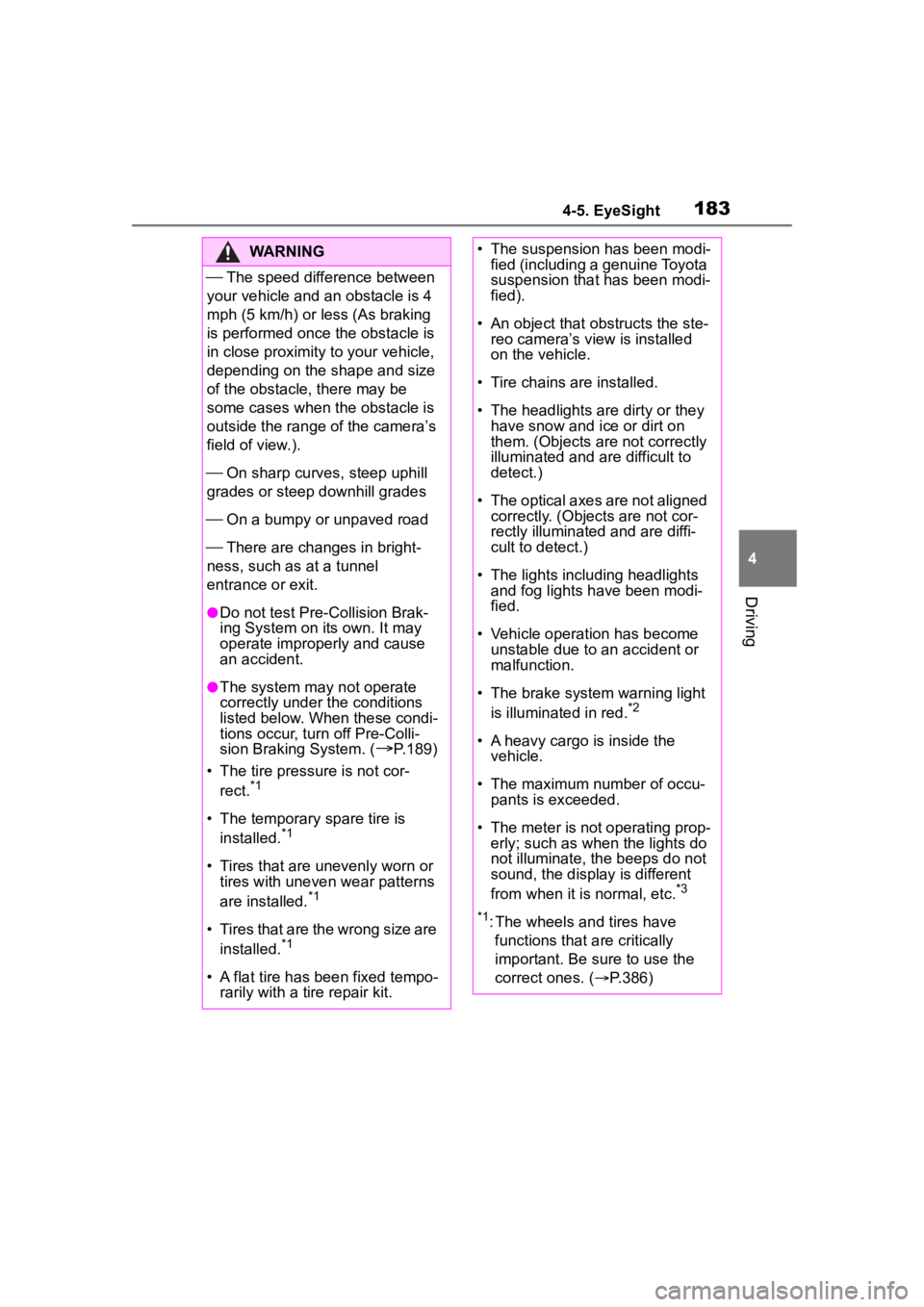
1834-5. EyeSight
4
Driving
WARNING
The speed difference between
your vehicle and an obstacle is 4
mph (5 km/h) or less (As braking
is performed once the obstacle is
in close proximity to your vehicle,
depending on the shape and size
of the obstacle, there may be
some cases when the obstacle is
outside the range of the camera’s
field of view.).
On sharp curves, steep uphill
grades or steep downhill grades
On a bumpy or unpaved road
There are changes in bright-
ness, such as at a tunnel
entrance or exit.
●Do not test Pre-Collision Brak-
ing System on its own. It may
operate improperly and cause
an accident.
●The system may not operate
correctly under the conditions
listed below. When these condi-
tions occur, turn off Pre-Colli-
sion Braking System. (
P.189)
• The tire pressure is not cor- rect.
*1
• The temporary spare tire is installed.*1
• Tires that are unevenly worn or tires with uneven wear patterns
are installed.
*1
• Tires that are the wrong size are
installed.*1
• A flat tire has been fixed tempo-rarily with a tire repair kit.
• The suspension has been modi- fied (including a genuine Toyota
suspension that has been modi-
fied).
• An object that obstructs the ste- reo camera’s view is installed
on the vehicle.
• Tire chains are installed.
• The headlights are dirty or they have snow and ice or dirt on
them. (Objects are not correctly
illuminated and are difficult to
detect.)
• The optical axes are not aligned correctly. (Objects are not cor-
rectly illuminated and are diffi-
cult to detect.)
• The lights including headlights and fog lights have been modi-
fied.
• Vehicle operation has become unstable due to an accident or
malfunction.
• The brake system warning light is illuminated in red.
*2
• A heavy cargo is inside the vehicle.
• The maximum number of occu- pants is exceeded.
• The meter is not operating prop- erly; such as when the lights do
not illuminate, the beeps do not
sound, the display is different
from when it is normal, etc.
*3
*1
: The wheels and tires have functions that are critically
important. Be sure to use the
correct ones. ( P.386)
Page 184 of 449
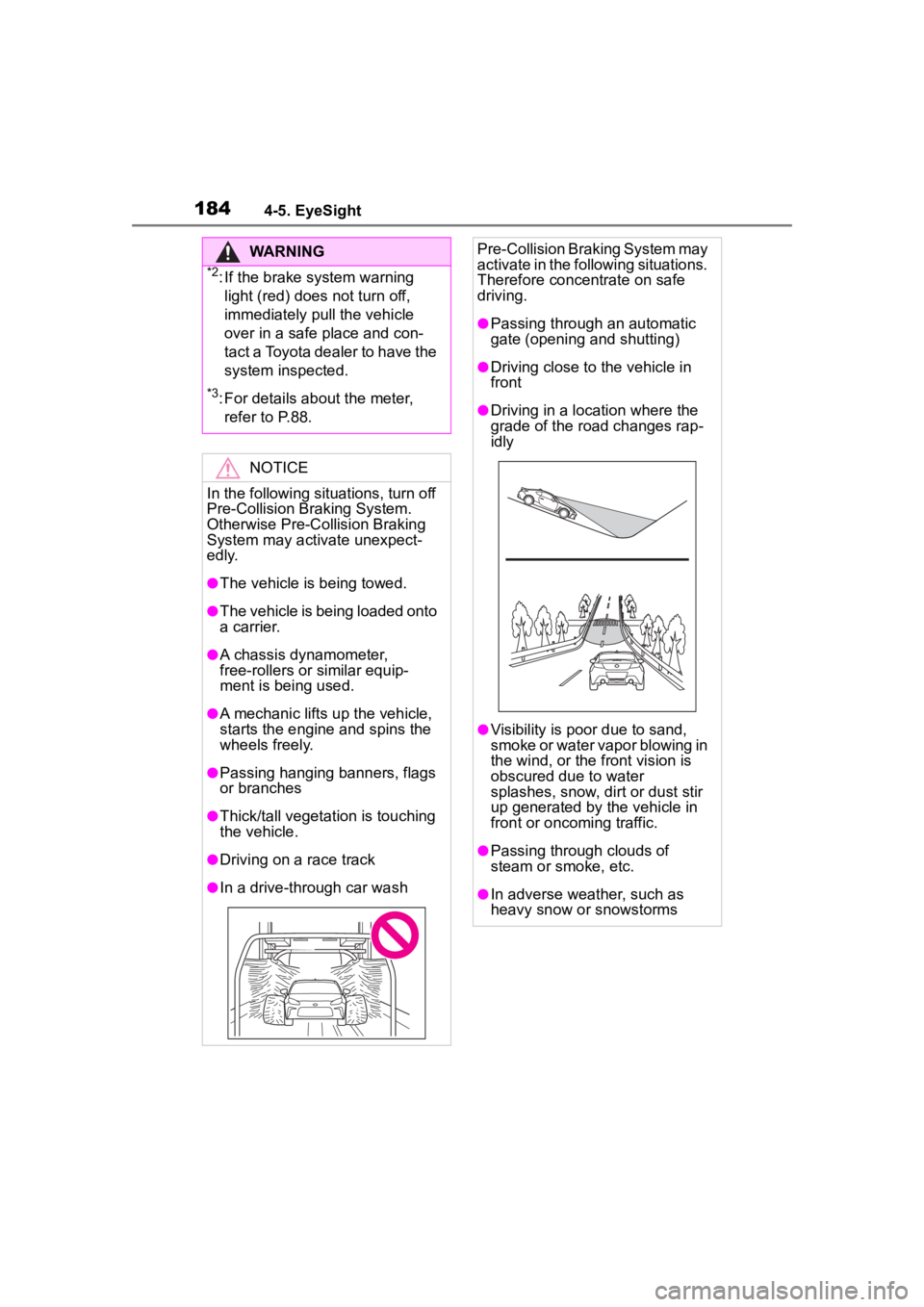
1844-5. EyeSight
WARNING
*2: If the brake system warning light (red) does not turn off,
immediately pull the vehicle
over in a safe place and con-
tact a Toyota dealer to have the
system inspected.
*3: For details about the meter,
refer to P.88.
NOTICE
In the following situations, turn off
Pre-Collision Braking System.
Otherwise Pre-Collision Braking
System may activate unexpect-
edly.
●The vehicle is being towed.
●The vehicle is being loaded onto
a carrier.
●A chassis dynamometer,
free-rollers or similar equip-
ment is being used.
●A mechanic lifts up the vehicle,
starts the engine and spins the
wheels freely.
●Passing hanging banners, flags
or branches
●Thick/tall vegeta tion is touching
the vehicle.
●Driving on a race track
●In a drive-through car wash
Pre-Collision Braking System may
activate in the following situations.
Therefore concentrate on safe
driving.
●Passing through an automatic
gate (opening and shutting)
●Driving close to the vehicle in
front
●Driving in a loc ation where the
grade of the road changes rap-
idly
●Visibility is poor due to sand,
smoke or water vapor blowing in
the wind, or the front vision is
obscured due to water
splashes, snow, dirt or dust stir
up generated by the vehicle in
front or oncoming traffic.
●Passing through clouds of
steam or smoke, etc.
●In adverse weather, such as
heavy snow or snowstorms
Page 185 of 449
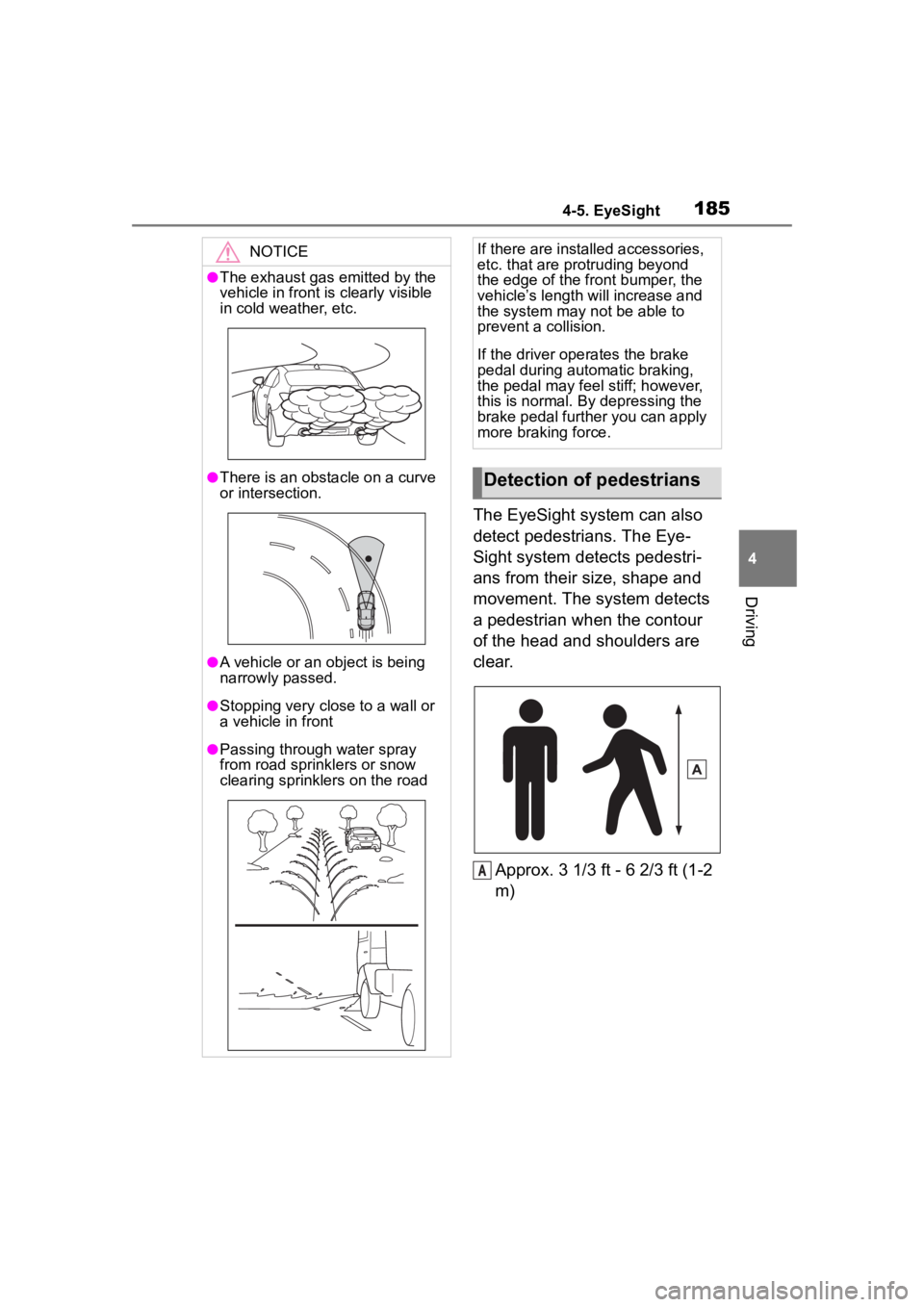
1854-5. EyeSight
4
Driving
The EyeSight system can also
detect pedestrians. The Eye-
Sight system detects pedestri-
ans from their size, shape and
movement. The system detects
a pedestrian when the contour
of the head and shoulders are
clear.Approx. 3 1/3 ft - 6 2/3 ft (1-2
m)
NOTICE
●The exhaust gas emitted by the
vehicle in front is clearly visible
in cold weather, etc.
●There is an obstacle on a curve
or intersection.
●A vehicle or an object is being
narrowly passed.
●Stopping very close to a wall or
a vehicle in front
●Passing through water spray
from road sprinklers or snow
clearing sprinklers on the road
If there are installed accessories,
etc. that are pro truding beyond
the edge of the front bumper, the
vehicle’s length will increase and
the system may not be able to
prevent a collision.
If the driver oper ates the brake
pedal during automatic braking,
the pedal may feel stiff; however,
this is normal. By depressing the
brake pedal further you can apply
more braking force.
Detection of pedestrians
A
Page 187 of 449
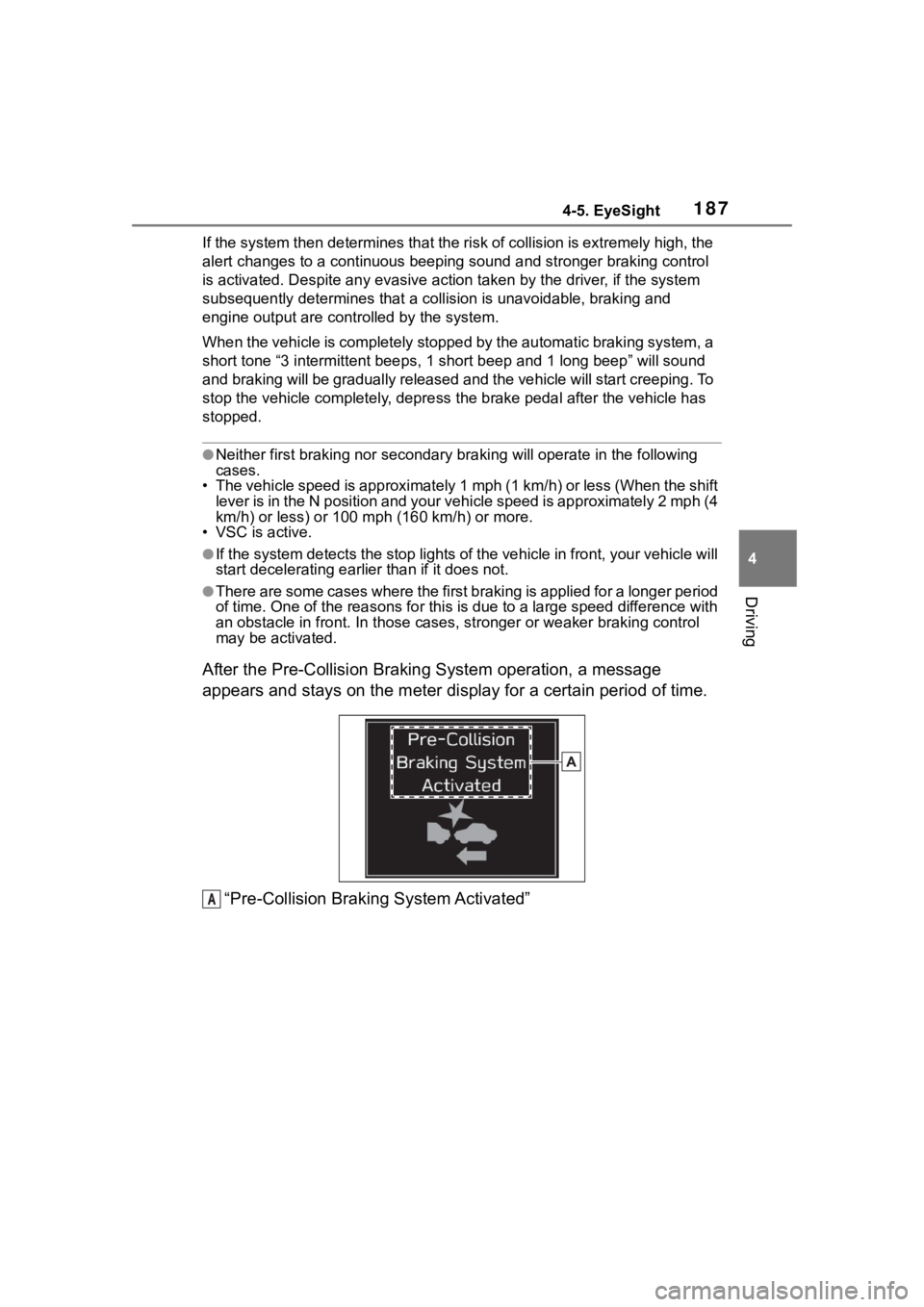
1874-5. EyeSight
4
Driving
If the system then determines that the risk of collision is ext remely high, the
alert changes to a continuous beeping sound and stronger brakin g control
is activated. Despite any evasive action taken by the driver, if the system
subsequently determine s that a collision is unavoidable, brakin g and
engine output are con trolled by the system.
When the vehicle is completely stopped by the automatic braking system, a
short tone “3 intermittent beeps , 1 short beep and 1 long beep” will sound
and braking will be gradually released and the vehicle will sta rt creeping. To
stop the vehicle completely, d epress the brake pedal after the vehicle has
stopped.
●Neither first braking nor secondary braki ng will operate in the following
cases.
• The vehicle speed is approximately 1 mph (1 km/h) or less (Whe n the shift
lever is in the N position and your vehicle speed is approximat ely 2 mph (4
km/h) or less) or 100 mph (160 km/h) or more.
• VSC is active.
●If the system detects the stop lights of the vehicle in front, your vehicle will
start decelerating earlier than if it does not.
●There are some cases where the first braking is applied for a l onger period
of time. One of the reasons for t his is due to a large speed difference with
an obstacle in front. In those cases, stronger or weaker brakin g control
may be activated.
After the Pre-Collision Braki ng System operation, a message
appears and stays on the meter display for a certain period of time.
“Pre-Collision Braking System Activated”
A
Page 188 of 449

1884-5. EyeSight
Following distance warning
Possible collision area
First braking and warning
Highly possible collision area
Secondary braking and warning
Extremely highly possible collision area
Obstacle
When Pre-Collision Braking
System is activated (when the
system determines that there is
a high risk of collision with an
obstacle in front), if the driver
depresses the brake pedal, the
system determines that this is
emergency braking and acti-
vates braking assist automati- cally.
Pre-Collision Braking Assist function
does not operate when the vehicle
speed is approximately 7 mph (10
km/h) or less or 100 mph (160 km/h)
or more.
Operating systemStrength of Auto-
matic BrakingIndication on the
multi-information display
Alert type
Following distance
warningWeakRepeated short
beeps
First brakingModerateRepeated short
beeps
Secondary brak-
ingStrongContinuous
beep
A
C
D
Pre-Collision Braking
Assist operation
Page 189 of 449
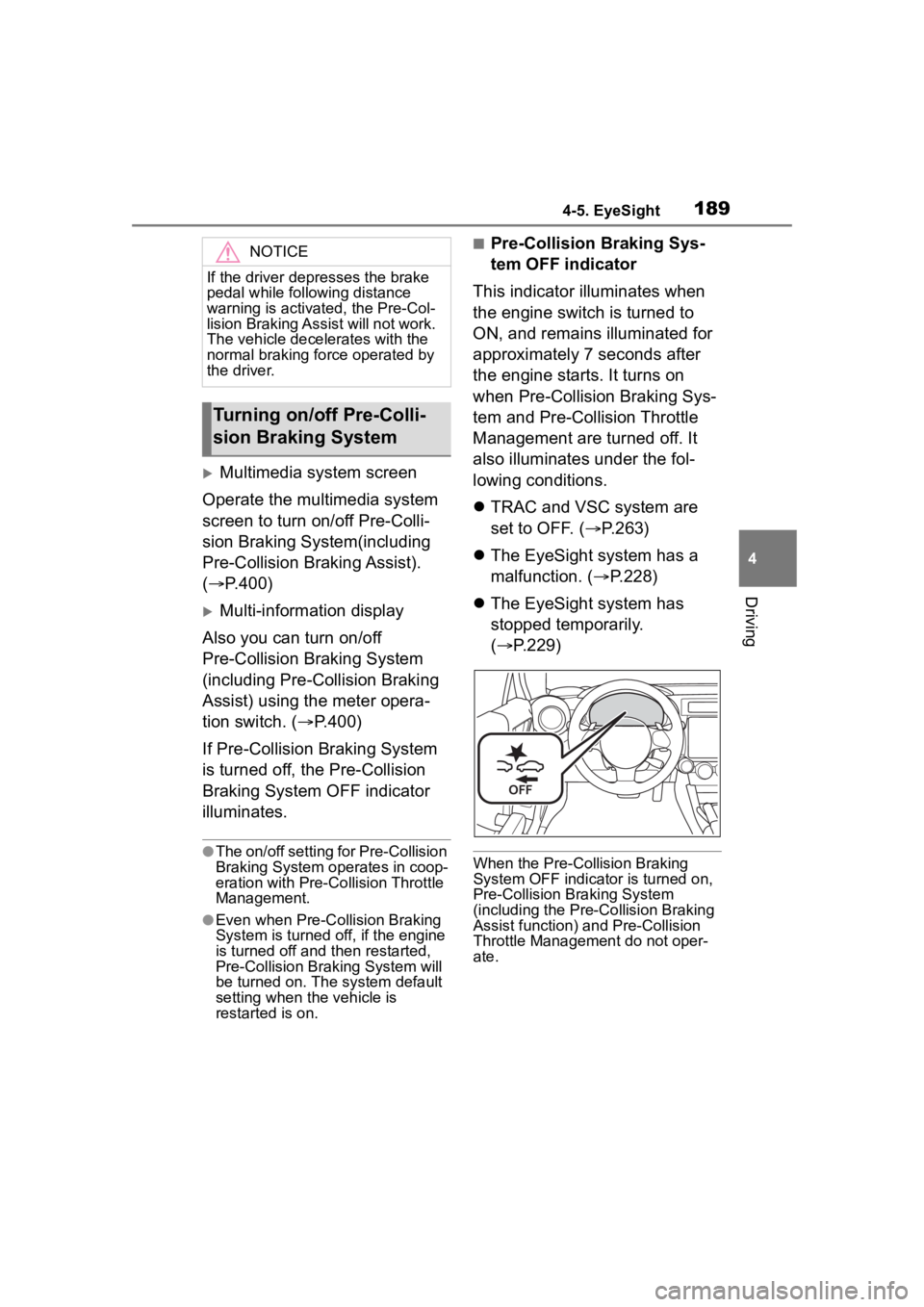
1894-5. EyeSight
4
Driving
Multimedia system screen
Operate the multimedia system
screen to turn on/off Pre-Colli-
sion Braking System(including
Pre-Collision Braking Assist).
( P.400)
Multi-information display
Also you can turn on/off
Pre-Collision Braking System
(including Pre-Collision Braking
Assist) using the meter opera-
tion switch. ( P.400)
If Pre-Collision Braking System
is turned off, the Pre-Collision
Braking System OFF indicator
illuminates.
●The on/off setting for Pre-Collision
Braking System operates in coop-
eration with Pre-Collision Throttle
Management.
●Even when Pre-Collision Braking
System is turned off, if the engine
is turned off and then restarted,
Pre-Collision Brak ing System will
be turned on. The system default
setting when the vehicle is
restarted is on.
■Pre-Collision Braking Sys-
tem OFF indicator
This indicator illuminates when
the engine switch is turned to
ON, and remains illuminated for
approximately 7 seconds after
the engine starts. It turns on
when Pre-Collision Braking Sys-
tem and Pre-Collision Throttle
Management are turned off. It
also illuminates under the fol-
lowing conditions.
TRAC and VSC system are
set to OFF. ( P.263)
The EyeSight system has a
malfunction. ( P.228)
The EyeSight system has
stopped temporarily.
( P.229)
When the Pre-Collision Braking
System OFF indicato r is turned on,
Pre-Collision Braking System
(including the Pre-Collision Braking
Assist function) and Pre-Collision
Throttle Managemen t do not oper-
ate.
NOTICE
If the driver depresses the brake
pedal while follo wing distance
warning is activat ed, the Pre-Col-
lision Braking Assist will not work.
The vehicle decelerates with the
normal braking force operated by
the driver.
Turning on/off Pre-Colli-
sion Braking System
Page 190 of 449
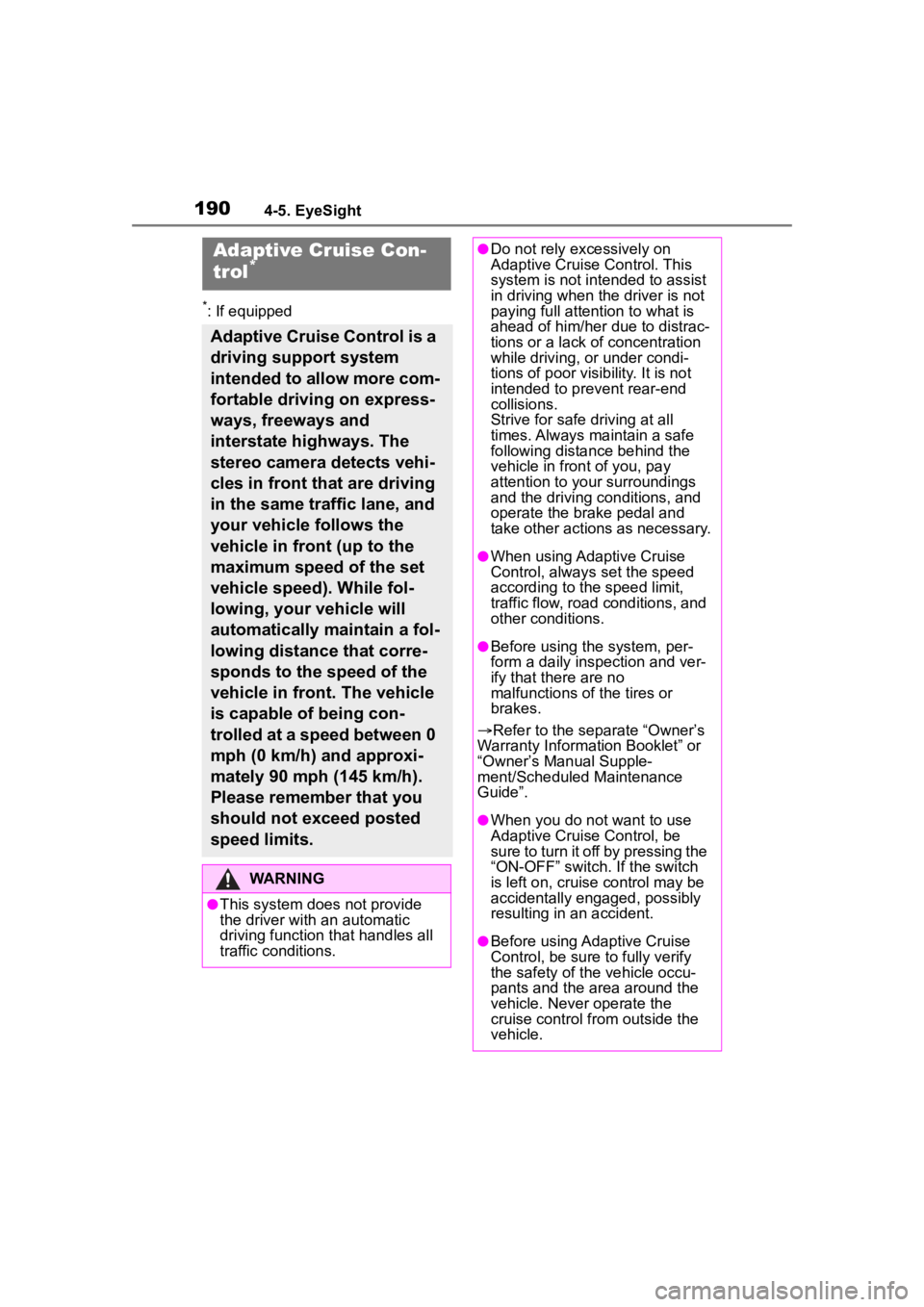
1904-5. EyeSight
*: If equipped
Adaptive Cruise Con-
trol*
Adaptive Cruise Control is a
driving support system
intended to allow more com-
fortable driving on express-
ways, freeways and
interstate highways. The
stereo camera detects vehi-
cles in front that are driving
in the same traffic lane, and
your vehicle follows the
vehicle in front (up to the
maximum speed of the set
vehicle speed). While fol-
lowing, your vehicle will
automatically maintain a fol-
lowing distance that corre-
sponds to the speed of the
vehicle in front. The vehicle
is capable of being con-
trolled at a speed between 0
mph (0 km/h) and approxi-
mately 90 mph (145 km/h).
Please remember that you
should not exceed posted
speed limits.
WARNING
●This system does not provide
the driver with an automatic
driving function that handles all
traffic conditions.
●Do not rely excessively on
Adaptive Cruise Control. This
system is not intended to assist
in driving when the driver is not
paying full attention to what is
ahead of him/her due to distrac-
tions or a lack of concentration
while driving, or under condi-
tions of poor visibility. It is not
intended to prevent rear-end
collisions.
Strive for safe driving at all
times. Always maintain a safe
following distance behind the
vehicle in front of you, pay
attention to your surroundings
and the driving conditions, and
operate the brake pedal and
take other actions as necessary.
●When using Adaptive Cruise
Control, always set the speed
according to the speed limit,
traffic flow, road conditions, and
other conditions.
●Before using t he system, per-
form a daily inspection and ver-
ify that there are no
malfunctions of the tires or
brakes.
Refer to the separate “Owner’s
Warranty Informat ion Booklet” or
“Owner’s Manual Supple-
ment/Scheduled Maintenance
Guide”.
●When you do not want to use
Adaptive Cruise Control, be
sure to turn it off by pressing the
“ON-OFF” switch. If the switch
is left on, cruise control may be
accidentally engaged, possibly
resulting in an accident.
●Before using Adaptive Cruise
Control, be sure to fully verify
the safety of the vehicle occu-
pants and the area around the
vehicle. Never operate the
cruise control from outside the
vehicle.